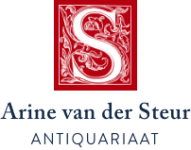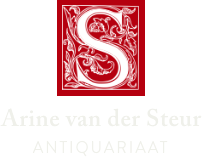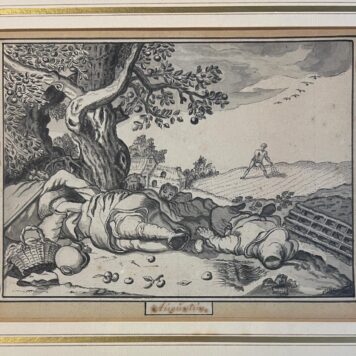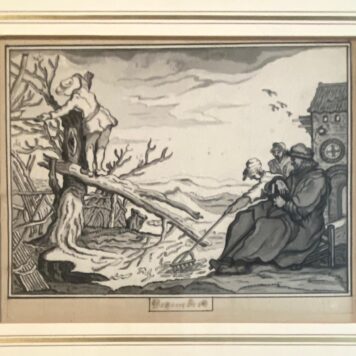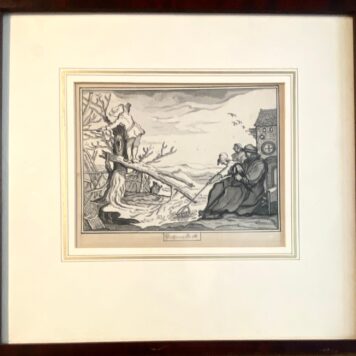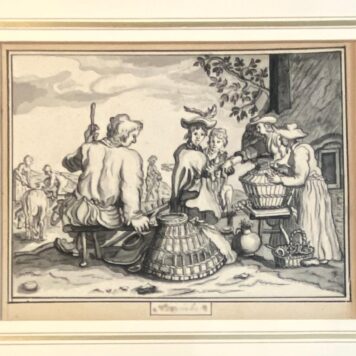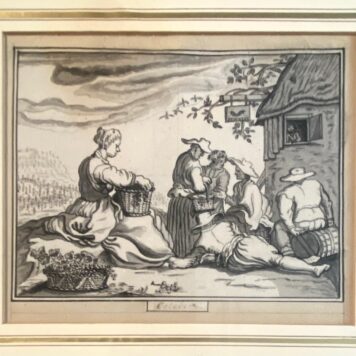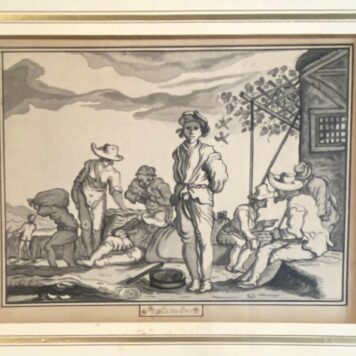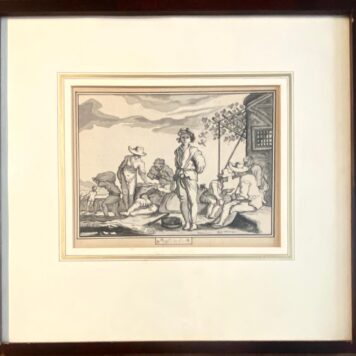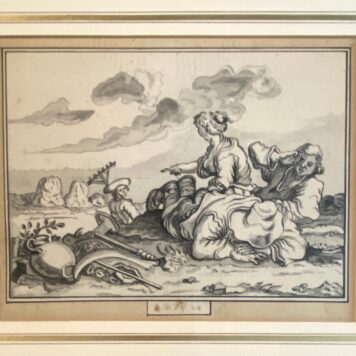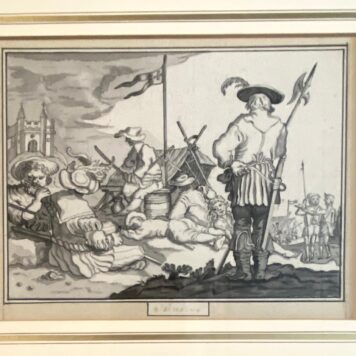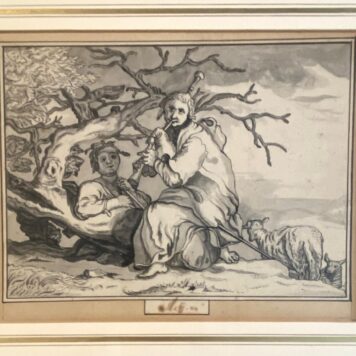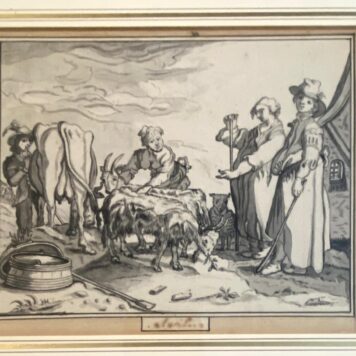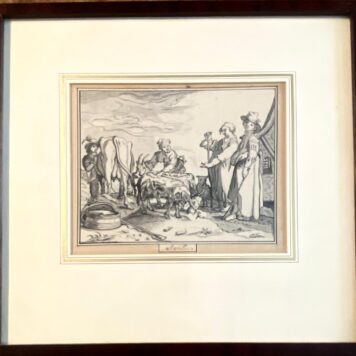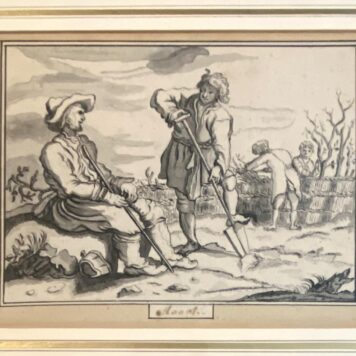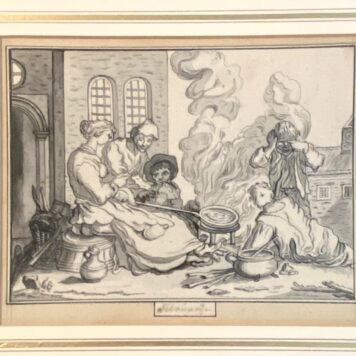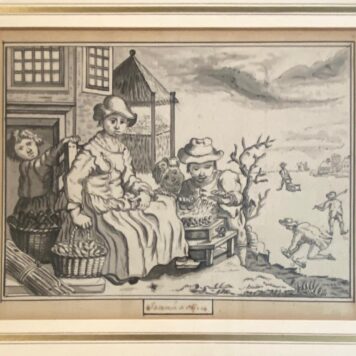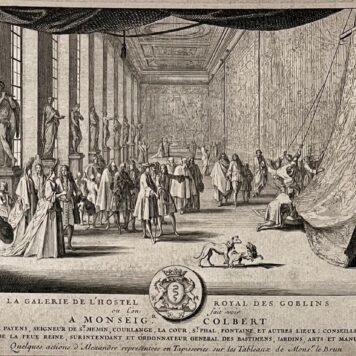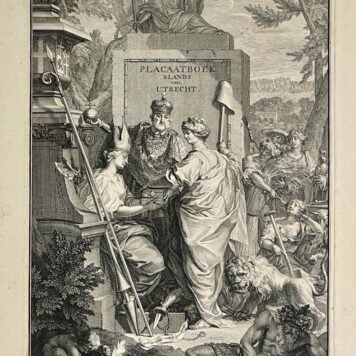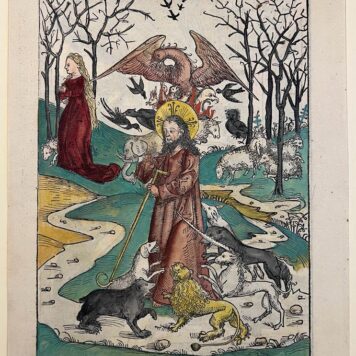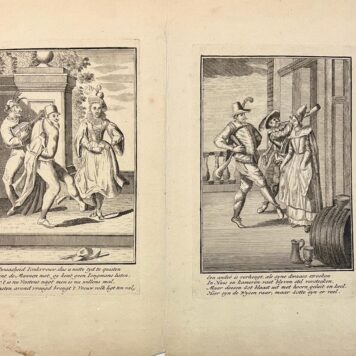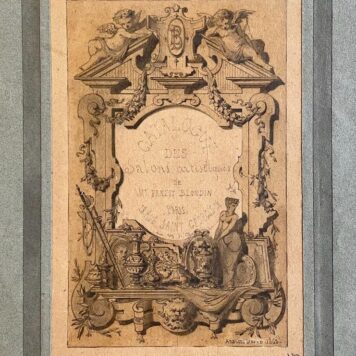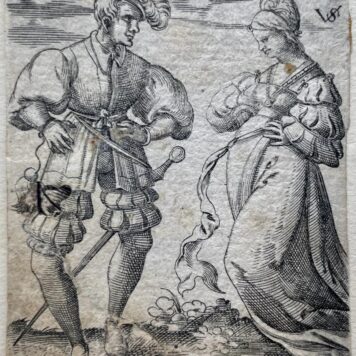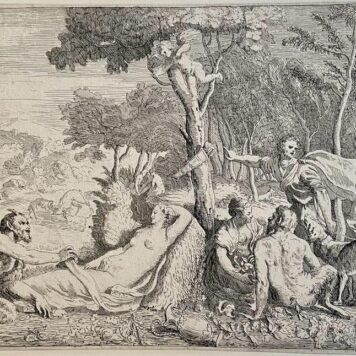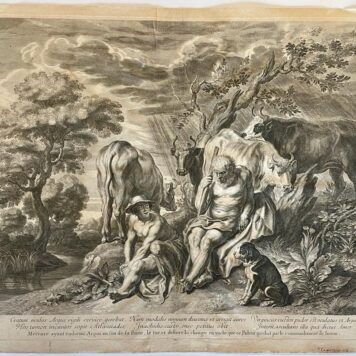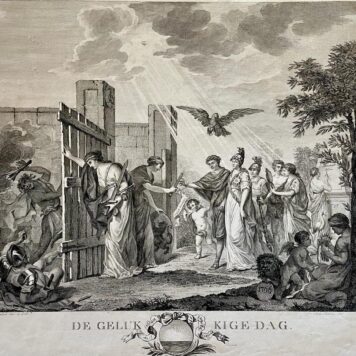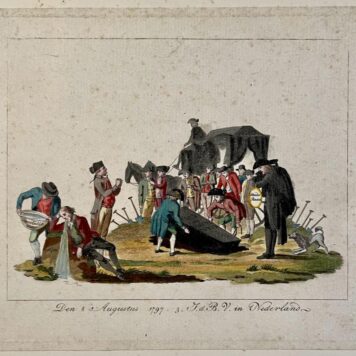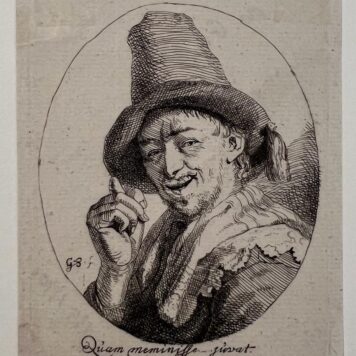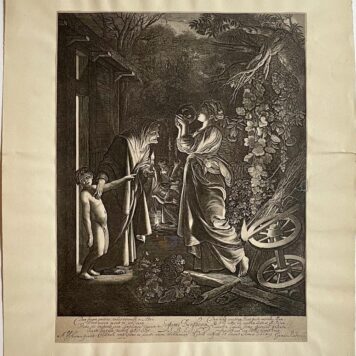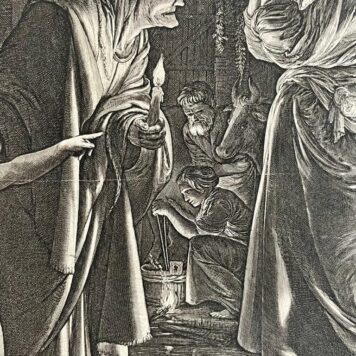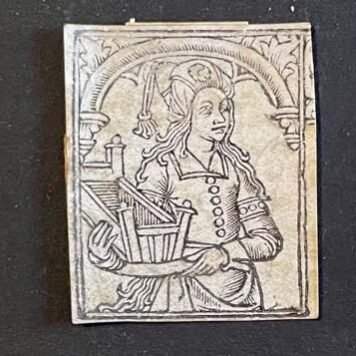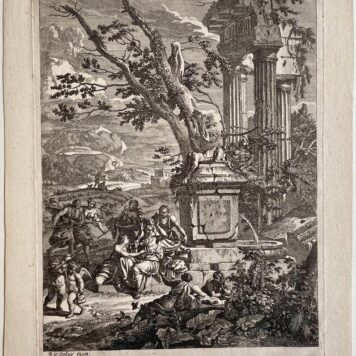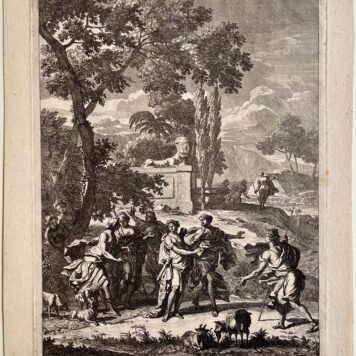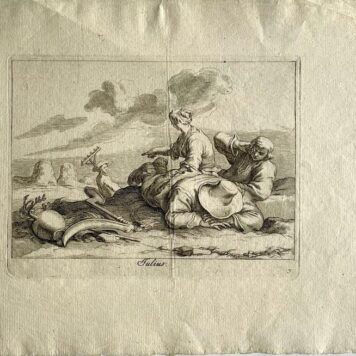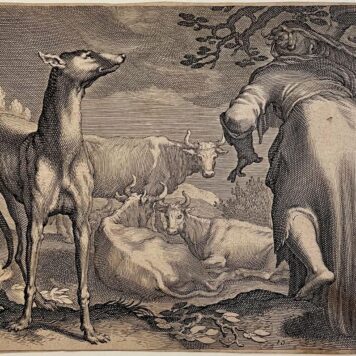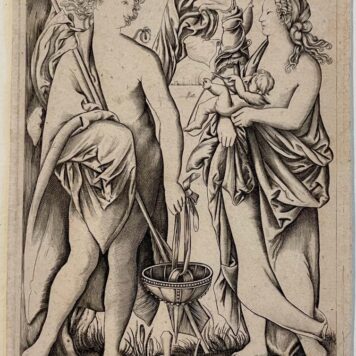An allegory is a narrative or visual representation in which a character, place, or event can be interpreted to represent a hidden meaning with moral or political significance. Authors have used allegory throughout history in all forms of art to illustrate or convey complex ideas and concepts in ways that are comprehensible or striking to its viewers, readers, or listeners.
Writers and speakers typically use allegories to convey (semi-)hidden or complex meanings through symbolic figures, actions, imagery, or events, which together create the moral, spiritual, or political meaning the author wishes to convey. Many allegories use personification of abstract concepts.
after Abraham Cornelisz. Bloemaert (1564/66-1651), Frederick Bloemaert (ca.1614-1690)
K80254
€ 145,20 (€ 120,00 ex. btw)
after Abraham Cornelisz. Bloemaert (1564/66-1651), Frederick Bloemaert (ca.1614-1690)
K80258
€ 145,20 (€ 120,00 ex. btw)
after Abraham Cornelisz. Bloemaert (1564/66-1651), Frederick Bloemaert (ca.1614-1690)
K80257
€ 145,20 (€ 120,00 ex. btw)
after Abraham Cornelisz. Bloemaert (1564/66-1651), Frederick Bloemaert (ca.1614-1690)
K80256
€ 145,20 (€ 120,00 ex. btw)
after Abraham Cornelisz. Bloemaert (1564/66-1651), Frederick Bloemaert (ca.1614-1690)
K80255
€ 145,20 (€ 120,00 ex. btw)
after Abraham Cornelisz. Bloemaert (1564/66-1651), Frederick Bloemaert (ca.1614-1690)
K80253
€ 145,20 (€ 120,00 ex. btw)
after Abraham Cornelisz. Bloemaert (1564/66-1651), Frederick Bloemaert (ca.1614-1690)
K80252
€ 145,20 (€ 120,00 ex. btw)
after Abraham Cornelisz. Bloemaert (1564/66-1651), Frederick Bloemaert (ca.1614-1690)
K80251
€ 145,20 (€ 120,00 ex. btw)
after Abraham Cornelisz. Bloemaert (1564/66-1651), Frederick Bloemaert (ca.1614-1690)
K80250
€ 145,20 (€ 120,00 ex. btw)
after Abraham Cornelisz. Bloemaert (1564/66-1651), Frederick Bloemaert (ca.1614-1690)
K80249
€ 145,20 (€ 120,00 ex. btw)
after Abraham Cornelisz. Bloemaert (1564/66-1651), Frederick Bloemaert (ca.1614-1690)
K80248
€ 145,20 (€ 120,00 ex. btw)
after Abraham Cornelisz. Bloemaert (1564/66-1651), Frederick Bloemaert (ca.1614-1690)
K80247
€ 145,20 (€ 120,00 ex. btw)
Dirk Sluyter (1790-1852) after Haatje Pieters Oosterhuis (1784-1854)
PR121514
€ 272,25 (€ 225,00 ex. btw)
after David Teniers the Younger (1610 - 1690)
PR121485
€ 302,50 (€ 250,00 ex. btw)
Dirk Sluyter (1790-1852) after Haatje Pieters Oosterhuis (1784-1854)
PR121515
€ 272,25 (€ 225,00 ex. btw)
Sébastien Leclerc I (1637-1714), Charles Le Brun (1619-1690)
PR121518
€ 181,50 (€ 150,00 ex. btw)
PR121516
€ 290,40 (€ 240,00 ex. btw)
Michel Wolgemut (1434-1519)
K80218
€ 968,00 (€ 800,00 ex. btw)
PR121470
€ 242,00 (€ 200,00 ex. btw)
PR121468
€ 121,00 (€ 100,00 ex. btw)
Jean Cotelle the Elder (1607 - 1676) [?]
K80189
€ 484,00 (€ 400,00 ex. btw)
Virgil Solis (1514-1562), after Jörg Breu II (1510 after-1547)
K80205
€ 181,50 (€ 150,00 ex. btw)
Anne Claude Philippe de Tubières, Comte de Caylus (1692-1765), after Titian (1489/90-1576)
K80161
€ 242,00 (€ 200,00 ex. btw)
François Ragot (fl. 1630s-1670), after Jacob Jordaens (1593-1678) published by Antoine Trouvain (1652?-1708)
K80167
€ 242,00 (€ 200,00 ex. btw)
Mattheus De Sallieth (1749-1791), after Jean Humbert (1734-1794)
K80166
€ 121,00 (€ 100,00 ex. btw)
Arnold Houbraken (1660-1719)
PR121458
€ 72,60 (€ 60,00 ex. btw)
Arnold Houbraken (1660-1719)
PR121459
€ 72,60 (€ 60,00 ex. btw)
Unknown master
PR121436
€ 145,20 (€ 120,00 ex. btw)
Cornelis Bogerts (1745-1817), after Christiaan van Waard (fl. 1793-1814), published by Banse and Nauman
PR121443
€ 145,20 (€ 120,00 ex. btw)
Bernard Picart (1673-1733)
PR121439
€ 108,90 (€ 90,00 ex. btw)
PR121457
€ 242,00 (€ 200,00 ex. btw)
Unknown master
PR121437
€ 181,50 (€ 150,00 ex. btw)
[Spotprent patriotten]
PR121456
€ 242,00 (€ 200,00 ex. btw)
Antonio Verico (1775-1846), after Vincenzo Seganti (fl. beginning 19th c.)
PR121445
€ 181,50 (€ 150,00 ex. btw)
Leendert Brasser (1727-1793), after François Joseph Pfeiffer (I) (1741-1807); text by Petrus Johannes Kasteleijn (1746-1794)
PR121444
€ 181,50 (€ 150,00 ex. btw)
after Godfried Schalcken (1643-1706)
K80221
€ 145,20 (€ 120,00 ex. btw)
Kolm, M.V.
PR121609
€ 145,20 (€ 120,00 ex. btw)
Hendrick Goudt (1583-1648), after Adam Elsheimer (1578-1610)
K80071
€ 1.452,00 (€ 1.200,00 ex. btw)
K80119
€ 363,00 (€ 300,00 ex. btw)
Frederick Bloemaert (ca.1614-1690), after Abraham Cornelisz. Bloemaert (1564/66-1651)
K80100
€ 121,00 (€ 100,00 ex. btw)
Richard van Orley II (1663-1732)
K80083
€ 181,50 (€ 150,00 ex. btw)
Richard van Orley II (1663-1732)
K80082
€ 181,50 (€ 150,00 ex. btw)
Frederick Bloemaert (ca.1614-1690), after Abraham Cornelisz. Bloemaert (1564/66-1651)
K80099
€ 121,00 (€ 100,00 ex. btw)
Cornelis Bloemaert (ca.1603-1692), after Abraham Cornelisz. Bloemaert (1564/66-1651)
K80106
€ 121,00 (€ 100,00 ex. btw)
Master HL (fl. 16th century)
K80113
€ 121,00 (€ 100,00 ex. btw)
